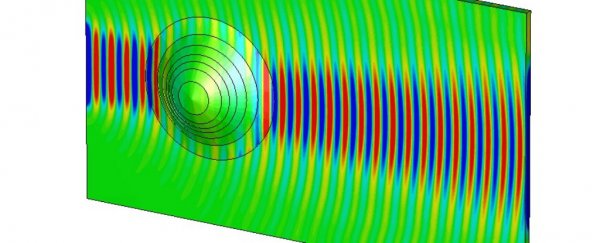Researchers from the UK have successfully made a raised object appear flat to electromagnetic waves – meaning that they are a step closer to having a full-blown cloaking device that can hide objects.
While the new findings are still far from a Harry Potter-style invisibility cloak, the successful experiment might help researchers develop better microwave and optical systems for commercial and industrial uses.
"The study and manipulation of surface waves is the key to develop technological and industrial solutions in the design of real-life platforms, for different application fields," team leader Luigi La Spada, from the Queen Mary University of London, said in a statement.
To pull off the feat, the team covered a raised surface with a newly developed 'nanocomposite medium' – which is basically a type of material that is made of different layers of nanoparticles, with each layer having a different electrical property. The material allows electromagnetic waves to hit the object and pass through without scattering, therefore, cloaking it.
"We demonstrated a practical possibility to use nanocomposites to control surface wave propagation through advanced additive manufacturing," Spada explains. "Perhaps most importantly, the approach used can be applied to other physical phenomena that are described by wave equations, such as acoustics. For this reason, we believe that this work has a great industrial impact."
In other words, the team developed a material that effectively cloaks an object from electromagnetic waves.
They don't go into detail how they came up with the nanoparticle material or how it works on a technical level – presumably because they're hoping to patent the technology – although we can kind of guess, based on previous nano-based cloaking projects.
For example, in September 2015, a team from Berkeley Lab in the US devised a cloaking device that works quite similarly to the one in the new study. As Peter Dockrill reported for us:
"The cloak works by employing specially devised metamaterials, which unlike natural materials can bend or curve the reflection of light via their physical structure rather than their chemical composition, essentially rendering objects optically undetectable. When light falls on the activated cloak, its array of nanoantennae distort the usual reflection of light from the object underneath, which makes it seem as if nothing is there."
Despite the fact that researchers are still far away from a true cloaking device, the team is super excited about the new material because it expands previous 'invisibility cloak' studies that found similar techniques worked with only one frequency.
"Previous research has shown this technique working at one frequency. However, we can demonstrate that it works at a greater range of frequencies making it more useful for other engineering applications, such as nano-antennas and the aerospace industry," team member Yang Hao explained.
Using nanoparticles isn't the only way researchers are trying to come up with an actual invisibility cloak, either. In 2014, researchers from the University of Rochester in New York created a lens that incorporates four different lenses with different focal lengths that basically bends light, giving the impression that an object has disappeared.
"There've been many high-tech approaches to cloaking and the basic idea behind these is to take light and have it pass around something as if it isn't there, often using high-tech or exotic materials," said John Howell, a professor of physics at the University of Rochester, in a press release back in 2014.
The bad news is that researchers have since calculated the limitations of cloaking devices, and found, that with current technology, we're never going to be able to get a cloak that fully hides humans or large objects like tanks across all wavelengths.
So for now we'll have to stay jealous of Harry Potter.
The new findings were recently published in the journal Scientific Reports.
